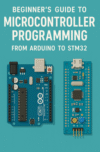There’s a universal truth in embedded systems: no matter how sharp your coding skills are, you’re only as good as the tools on your bench. Ask any seasoned engineer and they’ll tell you that debugging an embedded board without the right gear is like fixing a car engine with nothing but a butter knife. Sure, you might get by, but it’ll be messy, frustrating, and likely leave a few scars on the project timeline.
So, what belongs in the “must-have” kit for every embedded developer? Let’s walk through the essentials, the gear that separates the weekend tinkerer from the engineer who can take a board from blank PCB to fully functional prototype.
Multimeter: The First Responder
The multimeter is the stethoscope of embedded electronics. Checking supply rails, continuity, or that suspicious pin you think isn’t soldered properly—all of it starts here. A decent digital multimeter will save you hours of guesswork. Don’t cheap out too hard, though. The $5 ones from the bargain bin will mislead you faster than a poorly written datasheet.
A great starter multimeter is this one: https://amzn.to/45v313w
Oscilloscope
If the multimeter is your stethoscope, the oscilloscope is your X-ray machine. Embedded developers live and die by signals. PWM lines, UART chatter, power ripple—all of it is invisible without a scope. Even a modest two-channel scope gives you insights you just can’t get from code debugging alone. The first time you see a misbehaving I²C bus suddenly make sense under a scope, you’ll never look back.
A great oscilloscope: https://amzn.to/3UFSmfZ
This oscilloscope is small, extremely cheap, and very reliable for 90% of simple analog analysis.
For a more heavy duty one: https://amzn.to/3HKy6He
Comes with all the knobs and tweaks an advanced engineer might need.
Logic Analyzer: The Unsung Hero
Oscilloscopes show you waveforms, but logic analyzers tell you the story. Being able to capture a few seconds of SPI or CAN traffic and decode it into human-readable messages is a game-changer. You’ll thank yourself the first time you catch that “phantom” byte your MCU swears it never sent. Even the tiny USB plug-in analyzers are worth their weight in gold.
I can’t recommend this logic analyzer enough: Kings Logic Analyzer – https://amzn.to/45GGeAs
Simple to use, the free software is very intuitive to understand, comes with jumper wires and attachments for easy use with breadboarding and PCBs,
The software can be downloaded here: https://www.qdkingst.com/en/download
Jumper Wires and Breadboards
Before your design makes it to a clean PCB, you’re going to hack things together. Breadboards and jumper wires are the duct tape and zip ties of the embedded world. They let you quickly test pinouts, sensors, or timing quirks without spinning a new board. Keep a pile of both male-male and male-female jumpers—you’ll use them more than you think.
Buy this once, and never have to look under your desk for stray wires: https://amzn.to/3HLN9jQ
Buy breadboards for all your prototyping needs: https://amzn.to/41dT1Jl
Resistor and Capacitor Kits
You never realize how often you need a pull-up resistor until you don’t have one. Or that the quickest fix for a jittery line is a 0.1 µF capacitor sitting in your drawer. Having a well-stocked resistor and capacitor kit turns “ugh, I need to order parts” into “I’ll fix it right now.” These passive components are the unsung heroes of stable embedded systems.
This affordable kit will be enough for any wiring diagram or datasheet you need to recreate: https://amzn.to/460GHPc
Power Supply
USB ports are fine for development boards, but when you’re testing real hardware, you’ll want a bench power supply. Adjustable voltage, current limiting, and clean output give you control and protect your design from frying itself during bring-up. Bonus: you’ll learn a lot by watching how much current your system actually pulls when it wakes up.
Don’t starve your circuit; this power supply will give you all the AMPs you need: https://amzn.to/4mrwZLx
Other Essentials
- A decent soldering iron with temperature control. Forget the cheap pencil irons that burn traces more than solder.
- My recommendation: https://amzn.to/4fNhMC9
- Heat shrink and a hot air gun—because electrical tape is not a long-term solution.
- My recommendation: https://amzn.to/3VetTyw
- ESD mat and wrist strap if you’re working with sensitive ICs. One static zap can ruin your day.
- Don’t regret zapping your IC’s and turning them into bricked boards: https://amzn.to/3UHTtvJ
What’s funny is that these tools aren’t glamorous. They’re not the shiny new AI accelerator or the hot RISC-V chip making headlines. But in practice, they’re what keeps your project alive. Every embedded engineer eventually builds their own little ecosystem of go-to tools, and these are the cornerstones.
If you’re just starting out, invest slowly but wisely. A solid multimeter and some jumper wires can take you surprisingly far. Then, as your projects grow more complex, add the oscilloscope, the logic analyzer, and the rest of the gear. Before long, your workbench won’t just look like an engineer’s; it’ll feel like a command center.
Because in embedded systems, the line between frustration and breakthrough is often drawn by whether or not you had the right tool within arm’s reach.



